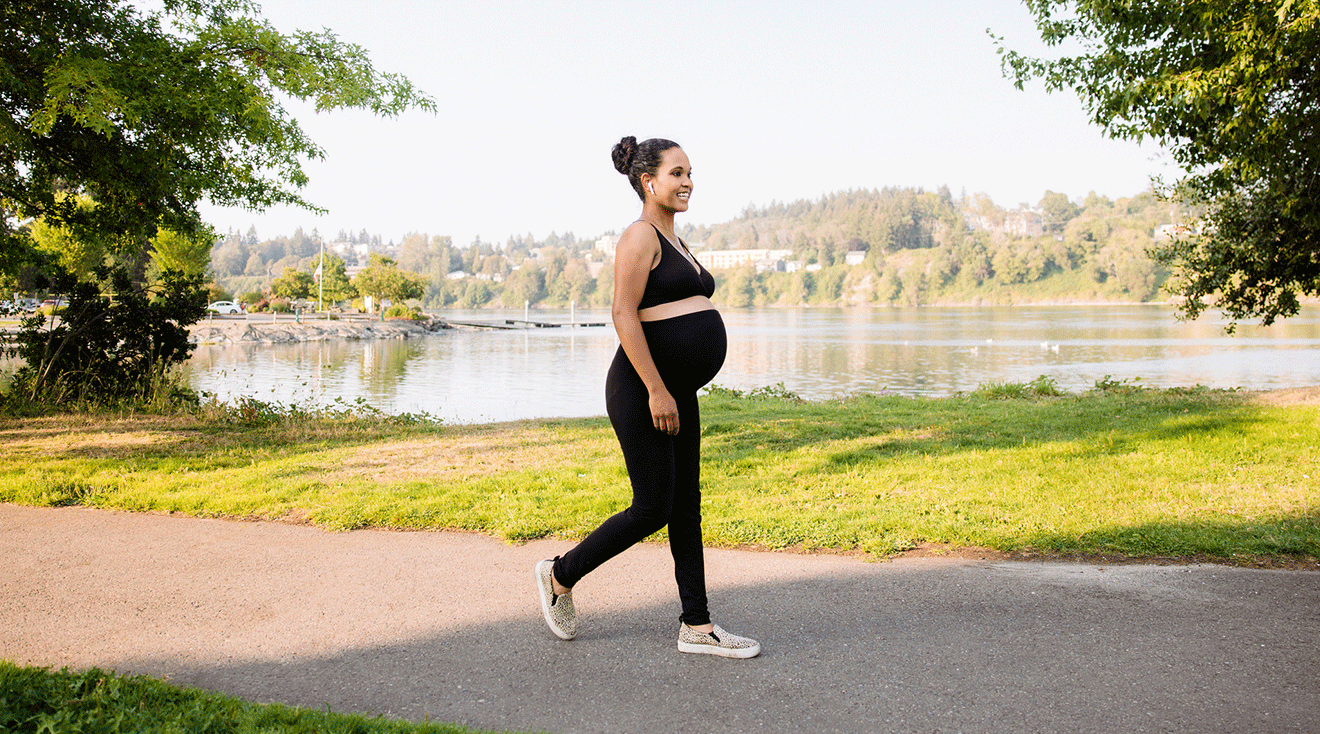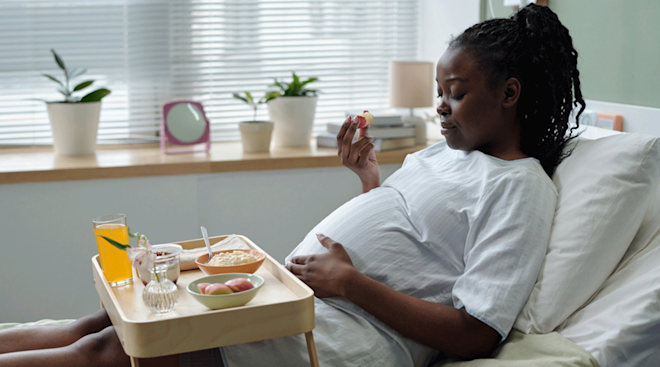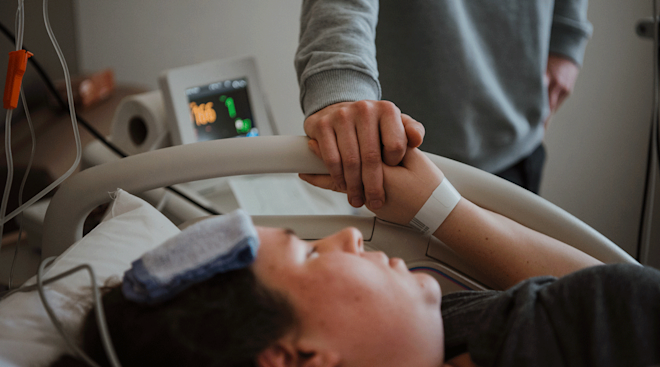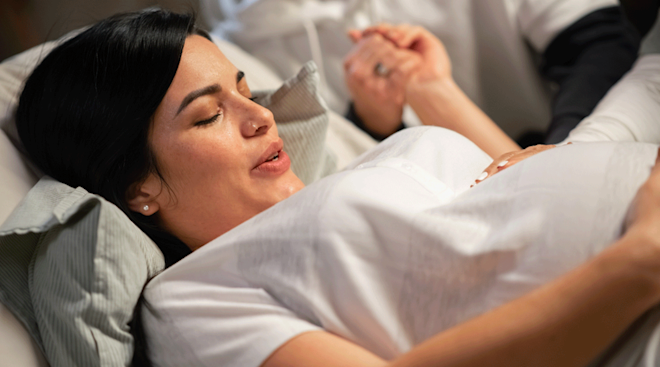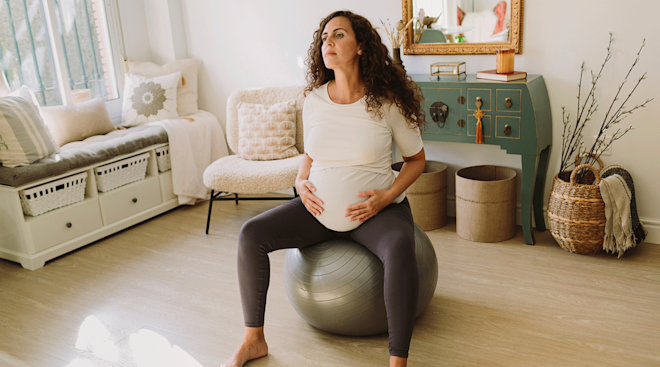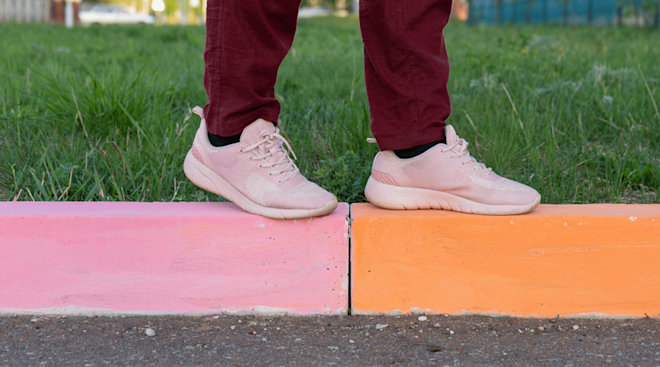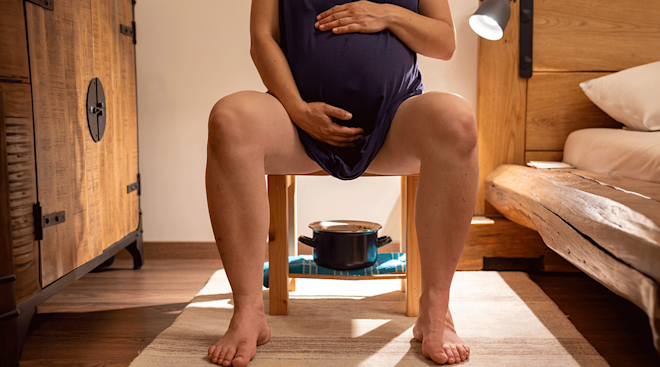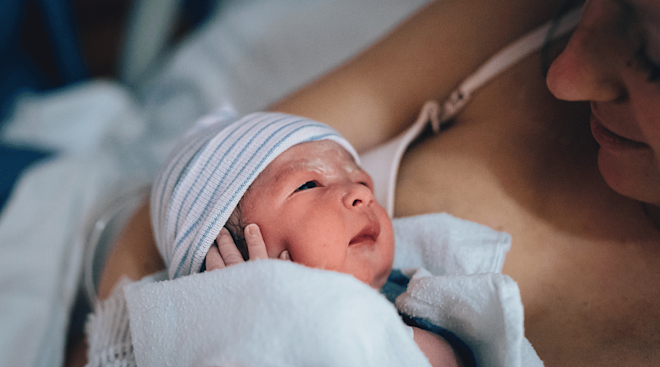How to Naturally Induce Labor: Truths and Myths
By the end of month nine, most moms-to-be are more than ready for baby’s eviction. You’re uncomfortable, you can’t sleep and you haven’t seen your feet in weeks—no wonder you’re counting down the days until you deliver. To that end, it’s no surprise that 22 percent of moms-to-be try to naturally induce labor themselves, according to one study. “Most women who are looking to naturally induce are at the end of their pregnancy and either want to avoid a hospital induction of labor, or their body is feeling tired and they want to get started sooner to relieve the aches and pains that come with pregnancy,” says Elizabeth Langen, MD, clinical associate professor of maternal and fetal medicine at the University of Michigan’s C.S. Mott Children’s Hospital in Ann Arbor.
But, for a number of reasons, hurrying the process along by trying natural ways to induce labor isn’t always the best idea. And it’s often not as easy or innocuous as you may think. So does sex induce labor? Should you go to town on spicy peppers or have someone give you a foot massage? If you’re wondering how to induce labor at home, read on. Here, prenatal experts are sharing the dos and don’ts.
Natural labor starts when a biochemical signal is sent from baby’s brain to Mom’s brain. This amazing process stimulates the mother to produce oxytocin, a hormone that causes the uterus to start contracting, leading to cervical changes—and voilà, labor begins. In contrast, when you induce labor, the uterus is stimulated (by you or, in the case of medicinal inducers, the doctor) to start contracting before nature kicks off the process on its own. “No one really knows the exact triggers that put a woman into labor naturally…It’s thought that once the baby’s lungs are fully developed a specific protein is released initiating labor to begin,” says Sherry Ross, MD, an ob-gyn, women’s sexual health expert and co-founder of Oneself Intimate Skin Care. “There are several variables that are thought to contribute to going into labor including the release of certain hormonal changes, the baby’s position and the body’s readiness for labor.”
So can you actually naturally induce labor yourself? Not necessarily. “Every culture has their own set of beliefs about what will bring on labor, but most of these aren’t backed up by science,” says Aldo Palmieri, MD, previous chair of obstetrics and gynecology at UCLA Medical Center in Santa Monica. Due to the lack of scientific evidence around what precisely stimulates labor in the body, if one of the suggestions on how to induce labor naturally does work for you, it could just be a coincidence, Ross adds.
First things first: Is it safe to try to naturally induce labor at home? According to Ross, most of the commonly used natural methods for inducing labor are safe, but you should always discuss your plans with your provider beforehand. You’ll want to wait until 39 weeks (assuming you have an accurate due date) to allow for baby’s lungs to completely develop before trying natural labor induction at home, she adds.
If you’ve had any pregnancy complications—like an increased risk of preterm labor, pregnancy-induced hypertension, poor fetal growth, placenta previa, etc.—or if you’ve gone past 42 weeks, you shouldn’t try inducing labor yourself, Ross says. “Always discuss your plans of inducing labor naturally with your healthcare provider to ensure it is a safe option to explore.”
As you approach the end of your pregnancy journey you’ll probably hear many suggestions about how to induce labor at home on your own. “There are many suggestions given by friends, mothers, grandmothers and next door neighbors about activities that’ll ‘definitely’ put you into labor,” Ross says. But to reiterate: There really aren’t any surefire ways to naturally induce labor, and some approaches may be unsafe for you and baby. Still, if you’re itching to move things along, here’s what experts say about what’s harmless to try (if you must), what might work and what natural methods for inducing labor you should absolutely avoid.
Eating spicy foods
If you’re wondering how to induce labor at home, you might want to start in the kitchen. There’s no research that shows chowing down on chili peppers or drowning your dinner in Sriracha can help expedite baby’s arrival, but some people think it could help move labor along, since the bowel is next to the uterus. “The idea is that if you irritate the bowel by eating spicy food, it’ll irritate the uterus as well, since it leans against it,” Palmieri says. But, again, studies haven’t shown this to be an effective way of inducing labor, so you’ll likely just end up with heartburn and a fiery mouth. (You may have also heard of eating pineapple to induce labor, but there’s nothing to back up that claim either.) Nevertheless, if you’ve got an intense craving and feel intent on figuring out how to induce labor naturally, this is a fairly harmless option to try.
Pineapple! Immense amounts of pineapple with deep squats. Worked all three times for me within 48 hours.
Going for a walk
When researching how to naturally induce labor, this might be one of the simplest options. Plus, one study found that 32 percent of women reported that exercise—usually walking—helped induce labor. “Physical exercise is thought to bring on labor naturally by gravity and putting pressure of the head on the cervix to help open up the pelvis,” Ross says. While it may not be a proven way to induce labor at home, staying active during pregnancy is great for baby’s health and yours. In fact, Ross recommends walking for a minimum of 30 minutes three times a week. So unless you’ve been told to avoid exercise, go for that walk anyway!
Having sex
You may hear that getting busy will do the trick to get your labor started. But are the rumors true? Does sex induce labor? Sorry—research hasn’t been able to definitively determine that sex can speed up labor, but Palmieri says it’s easy to see why some may think it helps, since semen contains prostaglandin, a natural chemical that can soften the cervix and stimulate the release of oxytocin, causing contractions. (A synthetic version of prostaglandin is actually used by doctors to soften or ripen the cervix when inducing labor.) However, having contractions doesn’t necessarily mean you’re in labor, Palmieri explains. “If you’re at risk of preterm labor, your doctor may actually advise against sex.”
Not sure they did anything, but dates were nice when I craved something sweet. I went into labor on my due date, so maybe they did work.
Eating dates
Want to get things going and potentially induce labor naturally? Consider making dates a regular part of your diet in the last few weeks of pregnancy. Ross says they’re thought to soften the cervix, and a study found that eating them can increase effacement and dilation. What’s more, it may reduce the need for Pitocin, an intravenous synthetic version of oxytocin that kicks off uterine contractions.
Getting acupuncture
Some moms-to-be claim that the traditional Chinese method of stimulating points on the body with tiny needles helps to naturally induce labor, but most research shows that women who get acupuncture don’t go into labor any sooner than those who don’t use the needles. However, some studies do suggest that acupuncture can reduce the need for an epidural—so keep that in mind for when you finally do go into labor if you’re hoping for an unmedicated birth.
Trying acupressure
Over the course of your pregnancy, someone may have warned you about foot massages, claiming it could cause premature labor. But toward the end of your journey, you might start thinking both the massage and labor sound pretty good. And acupressure, another practice from traditional Chinese medicine, which involves targeting certain pressure points to redirect energy and stimulate parts of the body, may be what you’re looking for. Many people believe that acupressure could stimulate muscles and kick-start labor, Ross says, but research hasn’t backed this up. Still, you might as well enjoy that foot massage; studies have found that acupressure can help reduce the pain and length of labor.
Stimulating your nipples
Ross says this natural method for inducing labor is “probably the most medically studied,” as stimulating the nipple in a similar way to a baby sucking on it can cause a release of oxytocin (the hormone that helps jumpstart labor by causing contractions). It can lead to excessive, painful and potentially unsafe contractions, so use caution. This isn’t something to try without a doctor’s approval.
Desperate times call for desperate measures. But there are some natural ways to induce labor you’ll probably want to avoid altogether. Don’t try any of the following without the explicit approval of your provider.
Drinking castor oil
Ross touts this natural method for inducing labor as “one of the longest standing myths of inducing labor.” It’s true that consuming the oil may act as a laxative and stimulate the intestines, resulting in diarrhea and hormone production and, in turn, causing uterine contractions. In fact, one study found that drinking castor oil ups the chance of going into labor within the following 24 hours. Still, you’re better off skipping it, unless you’re trying it under a doctor’s supervision (and not just because downing the oil is beyond unappetizing). “Drinking mineral oil or castor oil can cause stronger contractions than you’d have normally, and with each contraction, blood flow to the uterus slows down a bit so the baby doesn’t get as much oxygen,” Langen says. “If your contractions are too strong or too close together, the baby can lose oxygen, which can be dangerous.”
Consuming certain herbs
If you’ve been researching how to naturally induce labor, you’ve likely come across any number of herbal supplements. Cohosh, evening primrose oil and red raspberry leaf tea are among the common suggestions you may find online. But there’s no evidence to support these methods to induce labor at home actually work, Ross says. You should actually avoid taking herbal supplements to induce labor, according to the Mayo Clinic.. They aren’t regulated by the FDA (Food and Drug Administration) and can have potentially dangerous side effects.
Frequently Asked Questions
Can I safely use any pills to induce labor at home?
“There are no medical proven ‘pills’ to induce labor at home,” Ross says, emphasizing that this method for inducing labor is unsafe and not recommended.
Why and when is labor induced medically?
Women and their providers may consider inducing labor for medical reasons if a continued pregnancy would put baby or Mom at risk. These situations include having gestational diabetes or high blood pressure, or being two weeks past your due date. (You don’t need to be medically induced if you’re only just past the full-term mark.) If your doctor thinks it’s best to induce labor, they’ll use in-hospital methods, such as Pitocin, to start uterine contractions.
Will a membrane sweep induce labor?
Technically this isn’t a way to induce labor at home. Rather, a membrane sweep is done at your provider’s office and involves them sweeping the fetal membranes (i.e. amniotic sac) with their fingers to release prostaglandins from the cervix, Ross says. It also helps separate it from your uterine wall, effectively rupturing it (i.e. “breaking your water”) and helping to start labor. Research has found this to be a safe and effective natural method for inducing labor with low risks for Mom and baby. However, you should never try to do this yourself.
So what triggers labor naturally? By now you probably know the answer, even if it bums you out to hear it. Unfortunately, nothing is guaranteed to reliably trigger labor naturally. “When your body is ready to go into labor it will… Mother Nature reminds us, safety first,” Ross says. We know that can be frustrating, but the truth is that baby’s in charge! Still, if you feel inclined, go ahead and ask about some of the safe natural ways to induce labor we’ve mentioned above to your doctor or midwife and see what they say. If you get the green light, there’s no harm in trying!
Please note: The Bump and the materials and information it contains are not intended to, and do not constitute, medical or other health advice or diagnosis and should not be used as such. You should always consult with a qualified physician or health professional about your specific circumstances.
Plus, more from The Bump:
Elizabeth Langen, MD, is a clinical associate professor of maternal and fetal medicine at the University of Michigan’s C.S. Mott Children’s Hospital in Ann Arbor. She received her medical degree from Stanford University in California.
Aldo Palmieri, MD, served as the chair of obstetrics and gynecology at UCLA Medical Center in Santa Monica until 2018. He earned his medical degree from The University of Rome La Sapienza.
Sherry Ross, MD, is an ob-gyn and women’s sexual health expert. She’s the author of She-ology: The Definitive Guide to Women’s Intimate Health. Period. and She-ology, The She-quel: Let’s Continue the Conversation. She’s also the co-founder of Oneself Intimate Skin Care and the Women's Health & Wellness School on the Mproov app. She earned her medical degree from New York Medical College.
The Journal of Perinatal Education, What Started Your Labor? Responses From Mothers in the Third Pregnancy, Infection, and Nutrition Study, 2014
The Journal of Maternal-Fetal & Neonatal Medicine, Castor oil for induction of labour: a retrospective study, August 2018
Mayo Clinic, Inducing labor: When to wait, when to induce, March 2024
Obstetrics & Gynecology, Acupuncture to induce labor: a randomized controlled trial, November 2008
BMJ Open, Complementary therapies for labour and birth study: a randomised controlled trial of antenatal integrative medicine for pain management in labour, November 2016
Oman Medical Journal, The Effect of LI4 Acupressure on Labor Pain Intensity and Duration of Labor: A Randomized Controlled Trial, November 2014
Journal of Midwifery & Reproductive Health, The Effect of Late Pregnancy Consumption of Date Fruit on Cervical Ripening in Nulliparous Women, October 2012
Springer Nature, Membrane Sweeping to Induce Labor in Post-term Pregnant Women: Success Rate and Outcomes, March 2023
Learn how we ensure the accuracy of our content through our editorial and medical review process.
Navigate forward to interact with the calendar and select a date. Press the question mark key to get the keyboard shortcuts for changing dates.
































